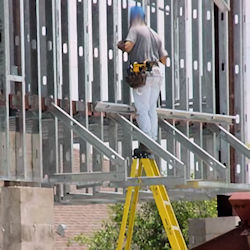Slips, Trips, and Falls
Introduction
Each year, falls consistently account for the greatest number of fatalities in the construction industry.
A number of factors are often involved in falls, including unstable working surfaces, misuse of or failure to use fall protection equipment, and human error. Studies have shown that using guardrails, fall arrest systems, safety nets, covers and restraint systems can prevent many deaths and injuries from falls.
Threshold Heights
When working at elevation above threshold heights, OSHA requires that employers provide fall protection in one of three ways before work begins:
- guardrail systems,
- safety net systems, or
- personal fall arrest systems.
Four Foot Rule: For general industry work, fall protection is required at elevations of 4 feet (1.2 m) or more above a lower level. (29 CFR 1910.28(b)(1)(i))
Six Foot Rule: Where workers on a construction site are exposed to vertical drops of 6 feet (1.8 m) or more above a lower level. (29 CFR 1926.501(b)(1))
Ten Foot Rule: If an employee is working on a scaffold, the height requirement for fall protection is 10 feet (3 m) or more above a lower level. (29 CFR 1926.451(g)(1))
Any Height Rule: Employers must also provide fall protection at any height where employees are exposed to hazards such as dangerous equipment, chemicals, or machinery, even if the work surface is below these thresholds.
A 51-year-old painting contractor at a residential apartment complex stepped onto a unsecured third-floor balcony, causing him to fall 21 feet onto the concrete below. As he lay injured, the balcony slid off its wall mount and landed on top of him. He died from his injuries.
An investigation by OSHA determined neither the contractor or subcontractor in this case had placed the required warning sign to alert the worker of the danger, and they had not tested the balcony's structural integrity or strength.
Hazard warning signs must be displayed and balconies, exits and high-level platforms must be blocked where practical during construction to prevent workers falling from heights or into active construction zones.
OSHA recommended the contractor and subcontractor pay substantial penalties.
Knowledge Check Choose the best answer for the question.
2-1. If an employee is working on a scaffold, what is the height requirement for fall protection?
You forgot to answer the question!

